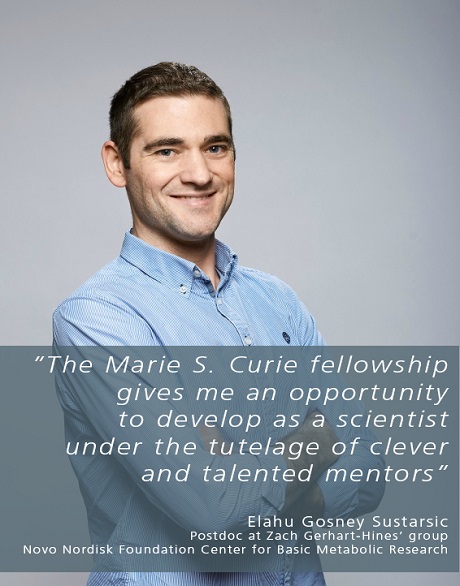Elahu Gosney Sustarsic receives a highly prestigious Marie Sklodowska-Curie Individual Fellowship.

Elahu Gosney Sustarsic, a postdoc in Zach Gerhart-Hines group, Section for Metabolic Receptology, receives a highly prestigious Marie Sklodowska-Curie Individual Fellowship. The grant from the European Union was received in January 2016 to investigate how the body’s endocrine system talks to specialized energy-burning fat cells to turn them on or off.
The project’s official title: An endocrine factor that integrates thermogenic and circadian signals to regulate brown adipose tissue activity
What is your project about?
This is a really exciting project with great potential.
Our research is focused on the twin pandemic of obesity and diabetes. While fat is at the center of this problem, we believe it can also be part of the solution, and so we are trying to find ways to use fat to maintain healthy blood sugar and burn calories.
Whereas white fat stores energy, there is another type of fat, brown fat, which burns energy to produce heat. It has been known for a long time that human infants have large amounts of brown fat to stay warm. Just a few years go several groups showed very convincingly that adult humans also have this specialized fat designed to burn energy.
This recent “rediscovery” of brown and brown-like fat in adult humans has generated a lot of interest in using the calorie-burning function of this tissue to help treat obesity and diabetes.
Our project builds on the classic activation of brown fat, cold temperature, as well as Asst. Prof. Gerhart-Hines discovery that this tissue is tightly regulated by the body’s internal clock. We believe we have found a key hormone circulating in the blood that integrates temperature cues and the natural daily rhythm of the body to switch calorie consumption on and off in brown fat.
How has the interest in carrying out this project evolved?
Well, I studied for several years in an endocrinology lab in the US. To be honest, I didn’t really give much thought to the biology of fat back then.
A few years ago, I coordinated a mouse study in which we disrupted a specific hormone pathway in mice. I asked everyone who was helping out what tissue they could dissect, and found someone for every tissue on the list, except for brown fat tissue, so I actually dissected and weighed this tissue myself. As I was cutting it out of the animals, I noticed that is was much bigger in some of the mice. As it turned out, this tissue was twice as big in the mice that had a disruption in this hormone pathway. I was busy finishing my PhD on a different topic, so these tissues just sat in the freezer, but I could never get the image of these large pieces of brown fat out of my head.
When I joined Asst. Prof. Gerhart-Hines' lab, I had the opportunity to look at the circadian and thermogenic regulation of this hormone pathway. We found that it is regulated by the two major biological mechanisms that switch brown fat on or off: temperature and the natural rhythm of the body’s metabolic clock.
This evolutionary conservation convinced us that the hormone could be important role and also provided convincing preliminary data that I used in the Marie Curie application. The project is really a perfect marriage of my previous work and the discoveries and core mission of my PI here at CBMR.
What scientific challenges can be expected through the project?
We laid out a pretty ambitious project that includes a number of experiments in cells, mice and humans. Fortunately, I’m surrounded by many extremely talented and hardworking people who can help me get this work done.
One of the toughest challenges will be to show relevance in humans. To overcome this, we have partners here in Copenhagen and in Aarhus who will help with human studies.
What does it mean for your career to receive a Marie Curie fellowship?
It’s such a great honour to be selected for this fellowship, really it’s a dream come true. This fellowship gives me an opportunity to develop as a scientist under the tutelage of clever and talented mentors. I love my job every single day, and I love the research environment here.
I am constantly amazed by the quality of the science that goes on here in Copenhagen, particularly at CBMR. My goal is to start my own group here in Denmark after my postdoc, and with hard work and a little luck, I hope this fellowship can help me achieve that.
What do you do when not researching?
I spend as much time as I can with my wife and our baby girl. Luckily, my wife is also a scientist, so I can talk science when I’m home. I do manage to squeeze in a few Danish lessons as well. And a few yummy Danishes.
